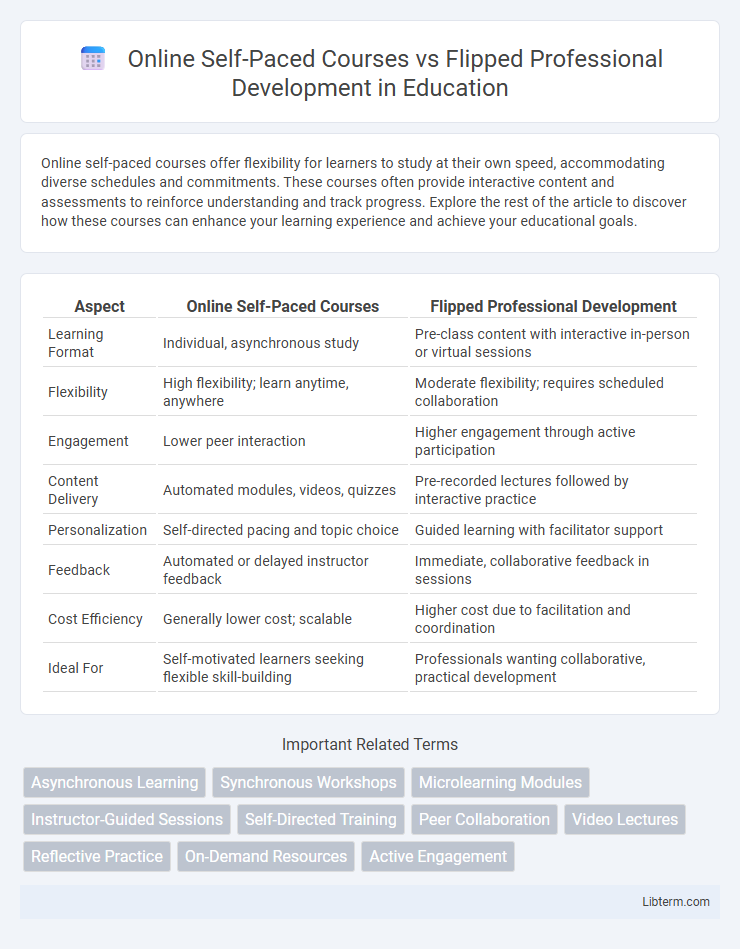Online self-paced courses offer flexibility for learners to study at their own speed, accommodating diverse schedules and commitments. These courses often provide interactive content and assessments to reinforce understanding and track progress. Explore the rest of the article to discover how these courses can enhance your learning experience and achieve your educational goals.
Table of Comparison
| Aspect | Online Self-Paced Courses | Flipped Professional Development |
|---|---|---|
| Learning Format | Individual, asynchronous study | Pre-class content with interactive in-person or virtual sessions |
| Flexibility | High flexibility; learn anytime, anywhere | Moderate flexibility; requires scheduled collaboration |
| Engagement | Lower peer interaction | Higher engagement through active participation |
| Content Delivery | Automated modules, videos, quizzes | Pre-recorded lectures followed by interactive practice |
| Personalization | Self-directed pacing and topic choice | Guided learning with facilitator support |
| Feedback | Automated or delayed instructor feedback | Immediate, collaborative feedback in sessions |
| Cost Efficiency | Generally lower cost; scalable | Higher cost due to facilitation and coordination |
| Ideal For | Self-motivated learners seeking flexible skill-building | Professionals wanting collaborative, practical development |
Understanding Online Self-Paced Courses
Online self-paced courses deliver flexible learning by allowing professionals to access content anytime, facilitating personalized skill development aligned with individual schedules. These courses often include multimedia modules, quizzes, and interactive exercises optimized for diverse learning styles, enhancing retention and application of new knowledge. The asynchronous format enables continuous progress tracking and fosters autonomy, making them ideal for time-constrained professionals seeking targeted upskilling.
What Is Flipped Professional Development?
Flipped Professional Development is an instructional approach where educators engage with course materials, such as videos and readings, independently before attending interactive, collaborative workshops or discussions. This method prioritizes active learning during in-person sessions, allowing teachers to apply concepts, analyze case studies, and participate in hands-on activities with peers. Compared to online self-paced courses, flipped professional development integrates pre-class preparation with dynamic, face-to-face engagement to enhance skill acquisition and professional growth.
Key Differences in Learning Formats
Online self-paced courses offer learners the flexibility to progress at their own speed, accommodating diverse schedules and learning preferences without real-time instructor interaction. Flipped professional development emphasizes active, collaborative learning by providing pre-class materials for independent study, followed by in-person or live virtual sessions focused on discussion, application, and feedback. The key difference lies in pacing and interactivity--self-paced courses prioritize individual autonomy, while flipped models blend autonomous preparation with guided, interactive engagement.
Flexibility and Time Management
Online self-paced courses offer unparalleled flexibility, allowing learners to access content anytime and progress at their own speed, which enhances effective time management. Flipped professional development requires scheduled participation but encourages active learning through pre-class preparation, maximizing live session productivity. Both models support diverse schedules, yet self-paced courses provide greater autonomy in balancing professional commitments and personal learning goals.
Engagement and Interactivity
Online self-paced courses offer flexibility but often lack real-time engagement, relying on pre-recorded videos and quizzes that may result in passive learning. Flipped professional development encourages active participation by using pre-class content to prepare participants for in-class discussions, fostering collaboration and deeper understanding. Interactive elements like live feedback, peer interaction, and hands-on activities in flipped models significantly enhance learner engagement compared to traditional self-paced formats.
Personalization and Learner Autonomy
Online self-paced courses offer high personalization by allowing learners to control the timing, pace, and sequence of their study, catering to individual learning styles and needs. Flipped professional development enhances learner autonomy by shifting traditional instructional content outside the classroom, enabling participants to engage with material independently and apply knowledge interactively during sessions. Both approaches emphasize personalized learning pathways and foster self-directed engagement, crucial for effective skill acquisition and professional growth.
Support and Instructor Involvement
Online self-paced courses offer limited instructor involvement, relying heavily on automated feedback and peer support forums to aid learners. Flipped professional development emphasizes active instructor participation through real-time guidance and collaborative problem-solving during in-person or virtual sessions. Support in flipped models is more personalized, fostering deeper engagement and immediate clarification of complex concepts.
Scalability for Organizations
Online self-paced courses offer unparalleled scalability for organizations by enabling thousands of employees to access consistent training simultaneously without geographic or scheduling constraints. Flipped professional development, while effective for interactive learning, often requires more facilitator involvement and coordination, limiting its scalability across large or dispersed teams. Organizations prioritizing rapid, broad skill dissemination typically benefit more from the scalable infrastructure of online self-paced learning platforms.
Assessing Outcomes and Effectiveness
Assessing outcomes in online self-paced courses often relies on automated quizzes, completion rates, and learner feedback analytics to measure knowledge retention and engagement effectively. Flipped professional development emphasizes interactive assessments, peer collaboration, and real-time instructor feedback, providing a deeper evaluation of practical skills and application. Comparing both approaches, combining data-driven insights from self-paced modules with qualitative assessments in flipped sessions leads to a comprehensive understanding of professional growth and learning effectiveness.
Choosing the Right Model for Your Needs
Online self-paced courses offer flexibility and allow professionals to learn at their own speed, making them ideal for busy schedules and varied learning preferences. Flipped professional development emphasizes interactive, in-person or virtual sessions where participants apply knowledge and engage in collaborative problem-solving, fostering deeper understanding and immediate feedback. Choosing the right model depends on factors like time availability, learning style, need for interaction, and organizational goals to maximize engagement and skill acquisition.
Online Self-Paced Courses Infographic

 libterm.com
libterm.com